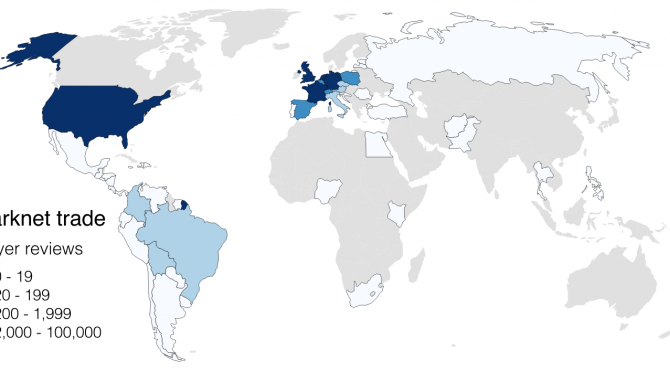
Dr Martin Dittus
Former Data Scientist at the OII
Digital geographer and data scientist. Mass-participation platforms, large-scale data analysis and visualisation, information geographies, social implications of emerging technologies.

Martin Dittus, Joss Wright, and Mark Graham have published a new paper and dataset on the economic geography of darknet marketplaces. Does recent growth of darknet markets signify a slow reorganisation of the illicit drug trade? Similar to their legal equivalents, these illicit markets allow the simultaneous presence of multiple types of actors on the same platform. They act as brokers in a multi-sided network between large numbers of supply- and demand-side participants, providing a shared interface for varied interactions that formerly took place on open markets. In principle this introduces opportunities to replace old intermediaries with new entrants, potentially reconfiguring the physical supply chains underlying these markets in the process. Have darknet marketplaces achieved such a reorganisation? What is their place in the global drug supply chain?
We used principles from economic geography to study these aspects in a rigorous and empirical manner. The framework of global production networks can be used to understand how global supply chains are formed. Central to the theory is the observation that such relationships are inherently spatial: there is a geography of production, distribution, and consumption. In the context of illicit drugs, such spatial profiling is possible for plant-based drugs such as cannabis, cocaine, and opiates. Their site of production can be determined with some precision based on biomarkers, as well as arrest records after large seizures, which makes it possible to distinguish supply and demand geographies in some detail.
Based on these foundations, we present the first study to address the economic geography of darknet markets in a comprehensive empirical manner, with a focus on the supply chain underlying these markets. Our study relates global darknet trading activity with the supply- and demand-side geographies of the three widely traded plant-based drug types cannabis, cocaine, and opiates.
We find that darknet markets are strongly characterised by a ‘last-mile’ geography. Vendors of cocaine and cannabis products are largely based in consumer rather than producer countries. They likely rely on existing trafficking channels for their supply, and distribute on darknet markets to a regional customer base. (Our analysis for opiates was inconclusive.) In other words, these are not fully globalised markets, but rather global platforms used for regional retail trade. Rather than removing or replacing existing supply chains, darknet markets are used for retail distribution in a small number of highly active consumer countries. This may in part be a risk management strategy: all delivery happens by mail, and international delivery incurs a greater risk of detection.
Study outcomes further suggest that darknet trading is largely shaped by existing global demand, rather than fostering new demand. As a result, it is likely that the economic incentives offered by this external demand yield a high ecological robustness against interventions.
Read our Creative Commons-licenced paper for further details: Martin Dittus, Joss Wright, Mark Graham (2018). Platform Criminalism: The ‘Last-Mile’ Geography of the Darknet Market Supply Chain. ACM The Web Conference 2018, Lyon. Free PDF at https://arxiv.org/abs/1712.10068. The data behind our analysis is available at https://dx.doi.org/10.5287/bodleian:E9jknXek6.
We will present our findings at the ACM The Web Conference in Lyon next week. Come say hi if you’re attending!
Follow our darknet research on Twitter at @OiiDarknet, and read further posts and press coverage here: https://www.oii.ox.ac.uk/research/projects/economic-geog-darknet/
